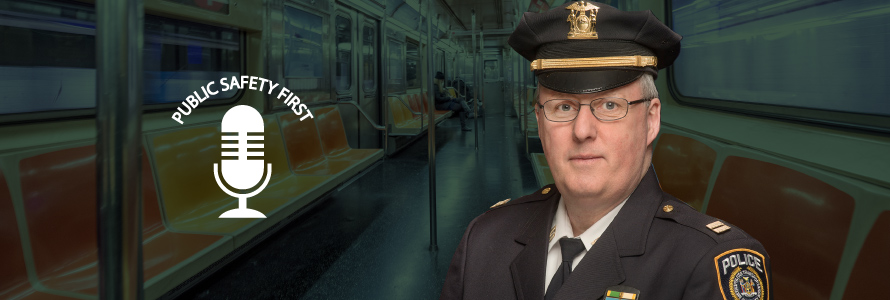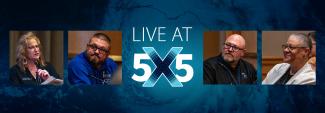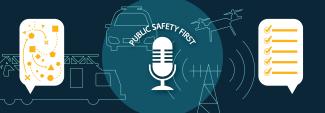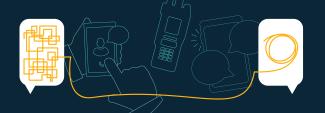Summary
For the New York State Metropolitan Transportation Authority Police Department, FirstNet is a critical supplement one of the most complex wireless radio systems in New York. FirstNet extends coverage to places in New York that historically lacked portable radio coverage, enhancing the connectivity for officers assigned to the New York City subway system and increasing interoperability with partners throughout the state.
Guest
David Cook
FirstNet Authority Senior Public Safety Advisor
Captain John Vallarelli
New York Metropolitan Transportation Authority Police Department
Transcript
Preview
Narrator: You're listening to Public Safety First, a podcast to help you learn about the First Responder Network Authority and how you can be part of the future of public safety technology.
And now, your host.
David Cook: Welcome to the Public Safety First podcast. I'm David Cook and I serve as a Senior Public Safety Advisor with the First Responder Network Authority. Today, I'm joined by Captain John Vallarelli, who is the head of communications at the New York State Metropolitan Transportation Authority Police Department. They happen to be the largest mass transit authority in the country, probably one of the largest in the world. Thank you, Captain, for joining us today, and welcome to the podcast.
Captain John Vallarelli: Thanks, David.
Narrator: You're listening to Public Safety First, a podcast to help you learn about the First Responder Network Authority and how you can be part of the future of public safety technology.
And now, your host.
David Cook: Welcome to the Public Safety First podcast. I'm David Cook and I serve as a Senior Public Safety Advisor with the First Responder Network Authority. Today, I'm joined by Captain John Vallarelli, who is the head of communications at the New York State Metropolitan Transportation Authority Police Department. They happen to be the largest mass transit authority in the country, probably one of the largest in the world. Thank you, Captain, for joining us today, and welcome to the podcast.
Captain John Vallarelli: Thanks, David.
David Cook: John, besides creating a friendship with me, what do you recall as a highlight of your career in law enforcement?
Captain John Vallarelli: I've had a few. So, from a law enforcement perspective, the time I spent as a detective doing dignitary protection during and post 9/11 down at the Trade Center. So, that was a very eye opening and a long, a memory, I don't really cherish too much. Throughout the career, you know, I've had an opportunity to be on the merger team that merged two of the MTA's railroad police agencies into the MTA police back in 1998. And that was the time when my responsibilities in communications came to a forefront when I was designated as a detective to be a lead to merge two agencies, communications systems, and dispatch functions into one operation. So, that started the balance of my career, which I am coming close to finishing up my 30th year in February.
So, the other piece of it was the completion, getting the opportunity to complete, fit out, and operational use of our brand-new emergency operation center back in 2003. I've been the agency's project manager for what is now defunct and defaulted statewide wireless network project, which you and I were a party to. We worked together, and that's when I met you, Dave.
David Cook: Quite a while ago.
Captain John Vallarelli: Yeah, we stayed friends all those years. Fast forward. I did get an opportunity to plant the seed for the development of a new radio system and because that failed and it moved in different directions, my career took that different step, and that's when I was the executive officer of communications in the Emergency Operations Center for the MTA PD.
David Cook: Tell me, how did the MTA communicate and share information when you first went on patrol? What were the early tools?
Captain John Vallarelli: The early tools was a single channel simplex VHF system that covered the entire jurisdictional area of the Metro-North Railroad, which was pretty much from Grand Central Terminal in Midtown Manhattan, up to Dutchess County and places like Poughkeepsie and Wassaic and out into Orange County and Port Service on the Pennsylvania border. So, we had a single VHF channel. In many places, there was no coverage. Dispatchers were dealing with some 70 different sites and having a real hard time finding our officers, knowing where they were. The challenges really were very bad. I mean, officer safety was a critical thing that was identified and that's where we started in communications. So, the jump for the opportunity to be on the program team for the Metropolitan Regional Radio System [MRRS], which is the trunked 700-megahertz system that we currently have that I've been a party to for about six years now, was ultimately the goal that we had and so, that's the crowning achievement, I think, was getting this system, getting the dream executed into a legitimate system and creating a very, very cohesive team with one mission, which was to get this system built.
David Cook: So, Captain Vallarelli, let's talk about FirstNet for just a moment. Was there a specific challenge that your team was trying to overcome when you were considering FirstNet?
Captain John Vallarelli: So, Dave, I want to go back a little bit to when the whole concept of FirstNet was coming around, prior to the contract with AT&T, was that I had a fear and I would, and I'm being honest in this assessment that we were trying to build on the P25 standard for public safety at about the same time that the broadband, the working groups were pushing the concept of FirstNet for broadband. There was much fear back then that it would hijack the efforts of the P25 efforts that agencies were funding, preparing to fund, had funded and were maintaining, and they would lose it to the commercial side. So, I watched with bated breath from afar, dabbled a little bit in it, but always had been a proponent of the concept, especially as I started to see the requirement come out, which seemed to have a very similar tone and texture to what our requirement was for our trunked 700-megahertz system. And at the very high level, that whole concept appealed to me. It appealed to me that the investment was being made congressionally for the funding through NTIA, and I started to really believe in the solution. But it would be extremely important to see how FirstNet could work to benefit us, not as a primary means of communication, but supplemental. And having, and not just supplemental for communications, but how could it provide for the greater MTA, being that we qualified as a transit agency and with many public safety and public service elements inside of it. It intrigued me. Attempts had been made from the AT&T FirstNet team to make it happen, but I believed in their commitment because I watched them commit to us.
We had to put 500 new officers in the subway system, and the worst-case scenario on that one was that the MTA would have to do this and put billions of dollars into putting the trunked radio system on the ground, which would have never been approved. And in looking at it and looking at the opportunity to leverage the L3 Harris system and the XL-200 portable, we challenged everybody to bring FirstNet to bear. Now being honest, when the first XL-200s came out, they were OK, it worked. But the software and the radio wasn't compatible to make it a one button switch, which is what our officers need. They need simplicity in everything they do. And that effort took upwards of a year of redevelopment of the software in the XL-200s, but in every step of the way AT&T FirstNet was there with us. So, every time we tested, they worked with us. Every time we needed a change, they were there with us. So, the group of the L3 Harris and AT&T FirstNet and the MTA PD was the one team approach that we had seen in our project, and that was the selling point. And when it worked and when it worked as well as it did, you couldn't get me to make a recommendation for anything but FirstNet. So, that is the success part of the story.
David Cook: Thank you for that. In a somewhat succinct manner, what does FirstNet do for the MTA?
Captain John Vallarelli: The FirstNet system supplied by AT&T provisioned in the XL-200 portable radios, provides a bridge where we do not currently have portable radio coverage and extends that coverage to places beyond the footprint of the MRRS, which is about 5,000 square miles in downstate New York, to places far and wide as we test it. So, it has been able to get our officers who were assigned into the New York City subway system to be able to leverage the LTE network that was built by a contractor for the MTA for LTE services. And we are bridging that into the LMR system successfully, and we've been doing that now for months. And the other benefit is, is in part of the testing period that we did, we engaged a series of facility types. So, where we tested in Penn Station, New York, and the Long Island railroad areas to the New York City transit subway system, we in ditto, we went into the, to suburban partners in the town of Eastchester and the villages of Bronxville and Tuckahoe. And we worked with them and said, "Tell us places that you are challenged for communications." And we brought the radios in and we tested our system and where we were challenged with is if those who know you get a bunk when you can't access the system. So, the radios that were switched to LTE bridged and worked. So, we tested within governmental building, we tested in schools. We tested in an old apartment complex, co-op complex. We tested in a new apartment complex and several locations where portable radio coverage may be suspect and in each time, because of the footprint provided by AT&T, we were able to bridge into the system and provide more than the coverage that we needed for an exceptionally low recurring cost. And for the budget crunchers and the people who have to manage these budgets in these extremely tough times, the value add for this is incalculable.
David Cook: Captain, I know testing was a major part of the department’s decision to move to FirstNet. Tell us a little bit about that testing process.
Captain John Vallarelli: Some of the testing we did was a Saturday morning and I was home sitting at my house and I got one of our LMR sites in pretty close range, so I got a really strong signal on a portable here. I was talking, one of our technicians was in our EOC, I was talking to him. I had another guy that was on Long Island and one of the engineers from L3 Harris was in Lynchburg, Virginia, and we were talking to each other in a conversation. We tested with New York State Homeland Security last year during the Buffalo Bills weekend, where the DHS technical staff was in Albany, where they're in a coverage footprint of a site that we built with them in Albany. I was downtown and this was a Thursday afternoon next to Grand Central Terminal communicating, and two of the technicians were driving along Interstate 90 to Buffalo. And when they got to the Buffalo Bills stadium, continued to have a conversation with us. So, we proved out again, the utility of this far beyond the current footprint. We can do this anywhere.
David Cook: That's very helpful. Captain, when you first started, your technology was a simplex voice-only radio system. How do you see data communications changing the way your officers do business? And are there any apps or devices that are today crucial to the operation?
Captain John Vallarelli: The thing I remind all vendors is, ultimately, your client may be the agency, but the end user is somebody who wants something that works simply. The use of apps and other devices, if they're not fixed in a vehicle and running all the time, become very cumbersome for patrol officers or firefighters or EMTs who are looking for rapid data access and rapid information. So, it's the integration of the back end with the front-end applications that are used currently that are helpful. Many local agencies, including the MTA, have a huge amount of data or video data from cameras and access control throughout. Taking those applications that are in the field currently deployed and how to integrate them to the mobile user or to a handheld in an incident scene or a tablet or a laptop where command and control can manage scenes. That's what we needed to do – getting people to look past their siloed systems and secure systems to bridge into an AT&T is very tough. But in the end, it would be extremely beneficial for users to have mapping, you know, to have drawing packages of facilities, to have the access control and the cameras to be able to see, get the situational awareness, so that decision makers can make those decisions. And in that case, we've looked at that from the public safety perspective and said that's important. But we saw something else.
In part of the agencies that were looking to join with us on board, the request came in that they needed schools covered for school resource officers [SRO]. In doing that, I said, and I think we talked in a previous call that we had had with your team, and I’ve spoken directly to AT&T on this one is, is if an SRO is assigned to a school and coverage has been provided, let's say, by a cell site, a local AT&T FirstNet cell site in that school, the leverage for the school is great, the leverage for the local agency protecting that environment is great. But what happens in a bad actor situation? Teachers in a classroom, something goes south, she hears something that's bad. How does she quietly make notification to the SRO so that the SRO can Z-axis into their location, find out where they are and also how can that audio and that trouble, we call it an emergency indication usually in the RF world, how does that be transmitted to a dispatch point to bring the necessary resources to bear? And the leverage in the schools, and I think we've had enough school shootings and school events in this country that if we don't start using our head with the technologies here and how to make that better, putting all the SROs and everything in place may not stop that from happening, but being able to report these things quickly can be a huge benefit.
David Cook: Thank you very much for that. It's very insightful. Can you share a specific example or two of when FirstNet actually made a difference in your police department's operations? Has your design and build out actually performed as you've expected?
Captain John Vallarelli: When we first turned it on and we put the first units on with the LTE to LMR interface in the BeOn, in the XL-200 and they transmitted for the subways for the first time, it was one of our assistant chiefs and two of the technicians that actually had gone down with it. The chief had the BeOn application on his phone and was able to talk back. He was able to communicate with the technicians who were there testing. And then the reaction from the rank and file when it worked was joy. Joy is a bad term in terms of cops because there's usually not joy. But there was satisfaction, clear satisfaction that they got it working down there. And when we don't hear the negative comments back, we know it's working because the cops will never give us good news. They usually give us bad news.
David Cook: Yeah, we can relate in the fire service, too.
Captain John Vallarelli: Same, it's all in public safety. It's the same thing all over, you know?
David Cook: Oh yeah.
For first responders who are not on FirstNet, but they're thinking about subscribing, what would you tell them?
Captain John Vallarelli: Hold AT&T FirstNet's feet to the fire. Ask for their coverage plots of the jurisdiction that you need to be in first. Know the coverage. Once you're satisfied that the coverage meets your requirement, sky's the limit, knock your socks off. Look at everything that they've got, determine what size fits for your agency, the applications, how FirstNet can benefit you. There's a small investment for something that if you did this on your own, most agencies could never afford it.
I realize my honesty, and I am an extremely transparent person. I don't sugarcoat it. And the one thing, honestly, in the past few years has steered me to FirstNet AT&T was cybersecurity. We invested heavily in our system, heavily. And I'm heavily relying on L3 Harris to step up and continue to operate and respond on foreign actors who may try to take the system out because there was a foreign actor attempt to breach our system and we stopped it. So, the cybersecurity plan that AT&T provided us took a long time for them to release that to us. But when they did, I was so satisfied that I tout that as a huge effort in agencies when we talk about bringing them on as a partner is to talk about the cybersecurity elements of it that are not a widget. They're not an app. It's not a black SIM card. It's what sits behind their network and what they do to keep it tight and right. And to that, I tip my hat off to them.
A director of a county 9-1-1 facility told me; you want to have a system that when you come home at night, you can put your head on the pillow, set your phone off, get a good night's sleep, wake up in the morning and maybe you'll react to an email from the overnight, but it isn't going to be a big deal. Honestly, I can say that after two and a half years of full operations, inclusive of a long time with AT&T and FirstNet, it's running like a champ.
David Cook: We've been speaking with Captain John Vallarelli of the New York State Metropolitan Transportation Authority, who was responsible for one of the most complex radio systems in New York state. And Captain Vallarelli, on behalf of the First Responder Network Authority, I want to thank you for spending a few minutes of your very important time to talk to us about public safety communications. Thank you and stay safe.
Captain John Vallarelli: Thank you very much, David.
Narrator: Thanks for listening today. We're excited to have you join our podcast community. Make sure to subscribe on iTunes, SoundCloud, and YouTube. You can learn more about the First Responder Network Authority at FirstNet.gov and learn about FirstNet products and services at FirstNet.com.























